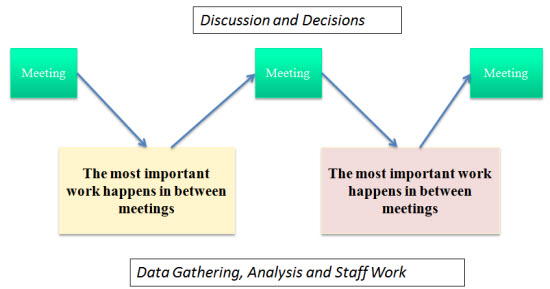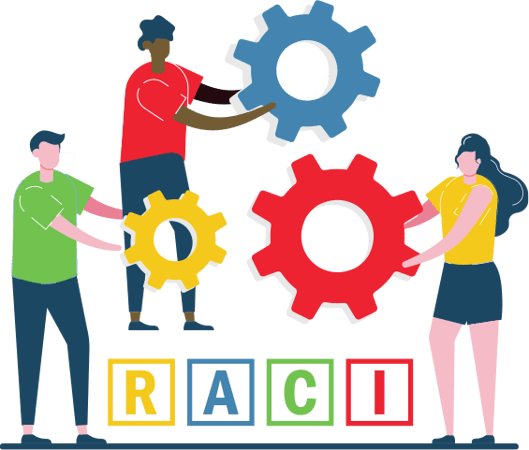If I told you there was a magic wand you could wave that would cut the number of meetings you have to attend in half, and make the remaining meetings twice as productive, would you want to use it? I’m betting you would, since most of my clients share a real frustration with the way meetings clog their calendars. Last week one of them, a CIO, lamented, “I can’t even start working on what I have to do until after dinner, because my days are just spent going from one meeting to the next!”
To understand the problem we need a graphic illustration of a basic truth that I will call here The Golden Ratio of Good Meetings:
To advance any project, the time spent working in between meetings is twice as important as the time spent in the actual meeting itself.
Notice how in the illustration below, the size of the meetings icon is relatively small, and the work done in between meetings is quite a bit larger.
First, the problem
What we have instead of the ideal illustrated above, is exactly the reverse. The time spent in meetings is larger – absorbing more and more of our time – and this crowds out the time spent working on the project in between meetings. This can become a vicious downward spiral – as the meetings become less productive, we conclude that we need to hold more of them to maintain the project momentum, and we squeeze out the time in between the meetings even more. Alas, this leads to less and less productive meetings. Eventually, people get discouraged and wonder why the project doesn’t seem to be going anywhere …?
Think of the work done in between the meetings as ‘nutrition’ that feeds a productive meeting cycle. When the nutrition time evaporates, our meetings grow weak and anemic.
Okay, now the solution
1. First, define the role of the group.
This is an essential first step to strengthening any kind of accountability. Is the group developing a recommendation? Offering advice and counsel? Receiving information? Or making a decision about something? It is possible – even likely – that the role of the group will shift with every item on its agenda. Whatever the group’s role is, make it clear to everyone.
2. Think about what kind of preparation work members of the group need to do, in order to perform their role well.Chances are, if the group is doing anything more than receiving information, people will need to come prepared to the meeting to do good work there. If you suspect that people haven’t had the time to come up to speed, reserve part of the beginning of the meeting as a “study hall” where people can read and absorb what’s important for the conversation.
3. Be rigorous about keeping track of Next Steps.Unproductive meetings often involve lots of conversation, but no clear path forward. As you facilitate or lead a meeting, make sure that you or someone else is winnowing all the discussion down into a concrete set of action steps.
4. Assign accountability for each Next Step, and set a deadline.A Next Step without an “owner” is not very likely to get done. The same problem exits for Next Steps with too many owners. Take the time to negotiate accountability for the follow up right then and there in the meeting, and make sure that someone writes it down. Then, when the group convenes again, make sure that person is written down on the agenda as the “owner” of that piece of the work.
These simple ideas will enhance accountability tremendously, and that in turn will enhance the effectiveness of your meetings. If you’re lucky, before long people will be asking you to cancel some of the project meetings so they can focus on the work they’ve committed to do in between – and you will have accelerated your project’s momentum with fewer meetings.
About RACI Solutions
RACI Solutions has been helping organizations across the globe utilize the power of RACI to transform the dynamic of cross-functional teams since 2007. Whether you are new to RACI or have used it for years, we can help.
Today’s business environment is complex – you may be contending with matrix structures, rapid growth, mergers, multiple locations, virtual employees, and/or digital transformation.
As a result, project teams can get stuck. Let us help you! If you need to learn RACI, we offer train-the-trainer materials and custom workshops. We can help you create RACI super-users. If you already use RACI or another decision matrix, we offer programs that help you become skilled at working across functions – an effective horizontal leader. We help project teams tune up their performance. We help organizations streamline their decision-making.
Our team is comprised of expert consultants, trainers, and facilitators, who can help your teams and their leaders achieve a seamless level of collaboration.






